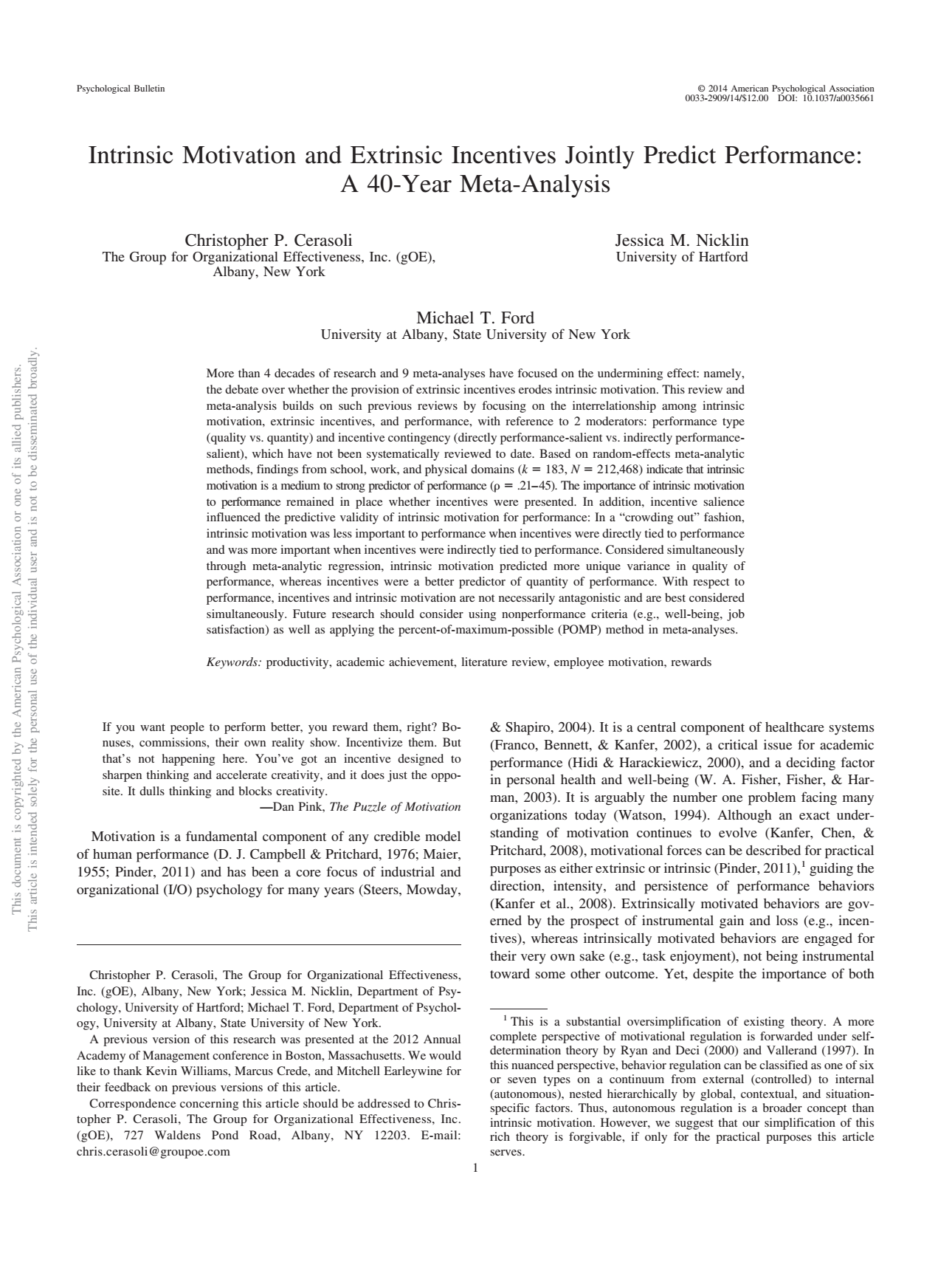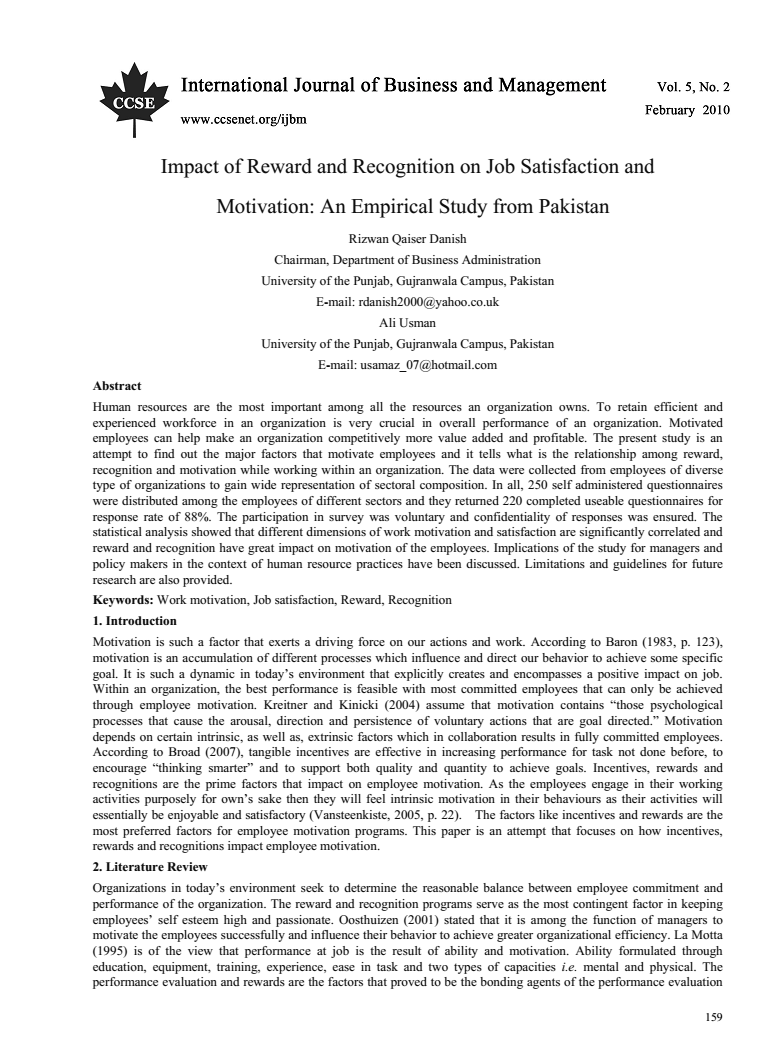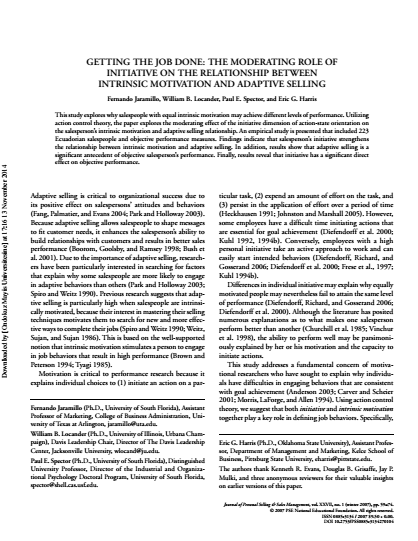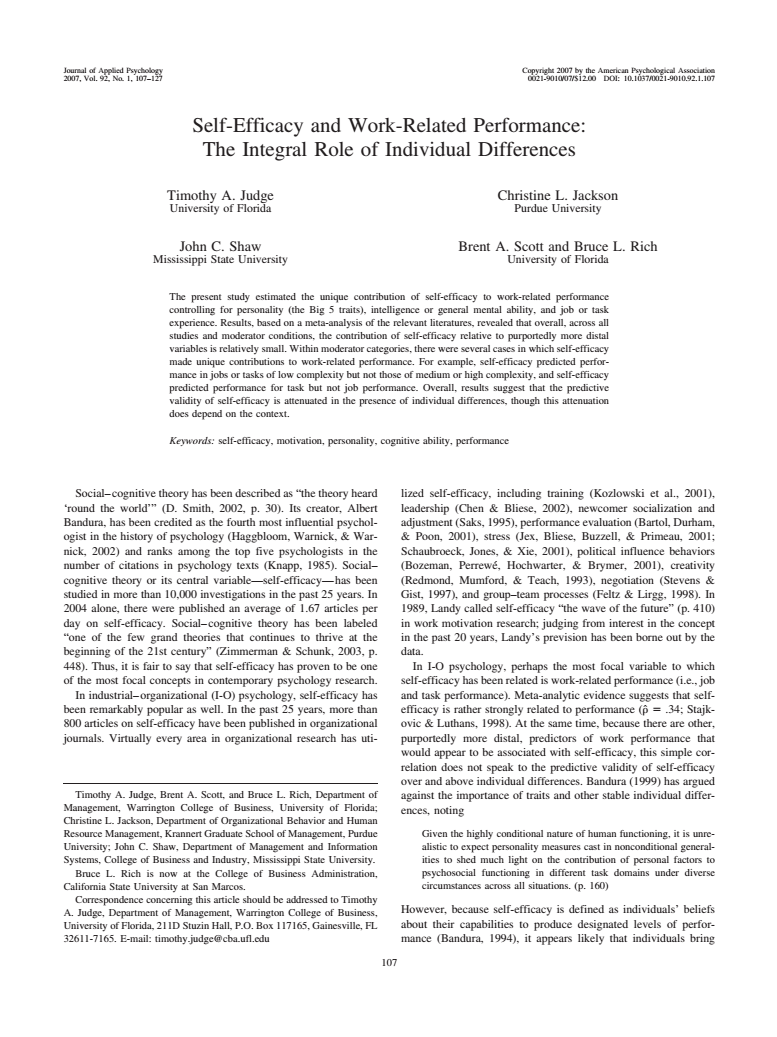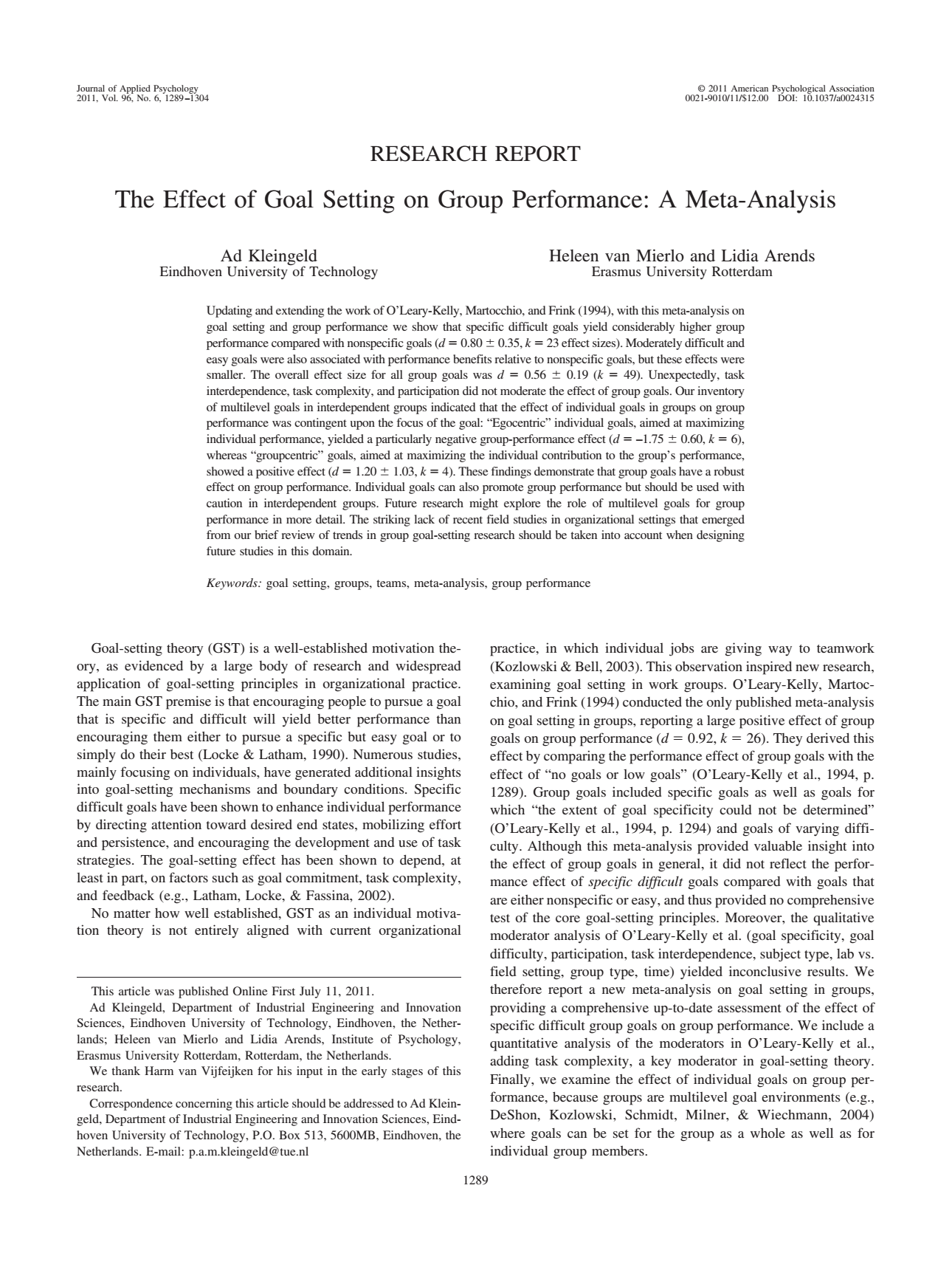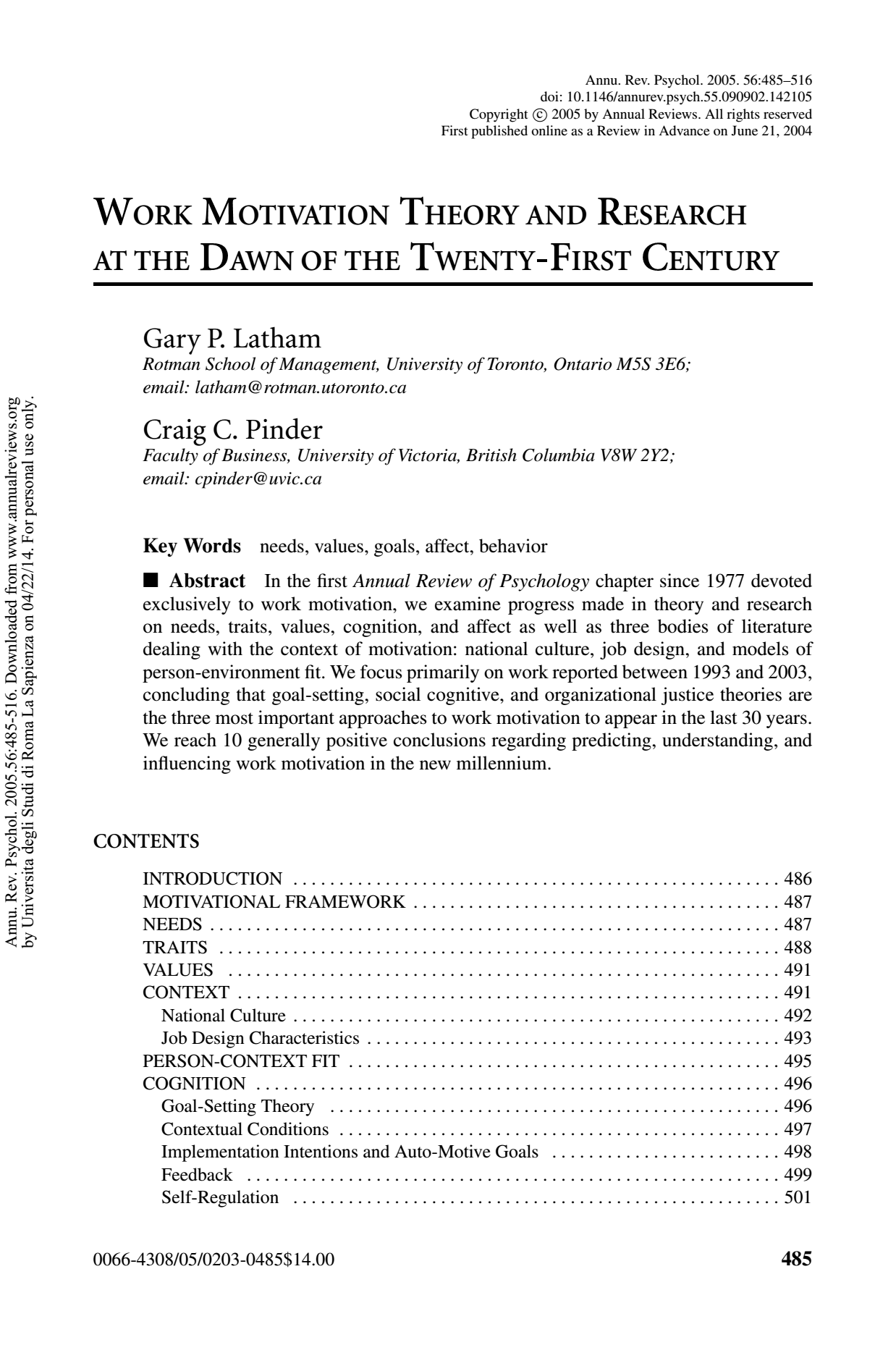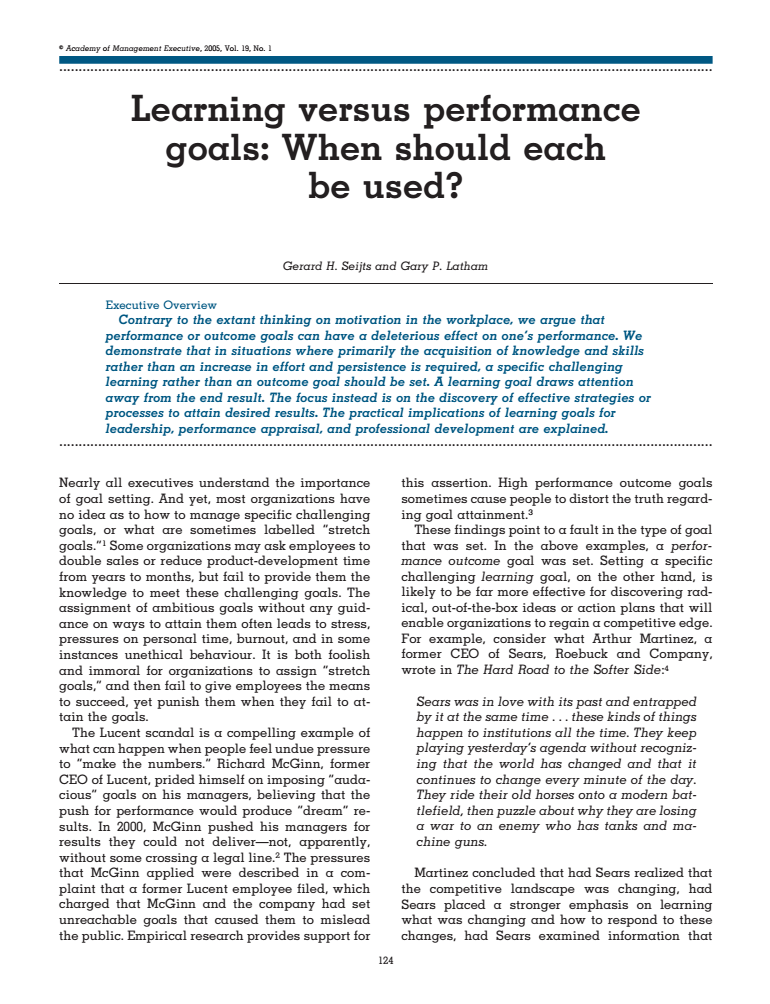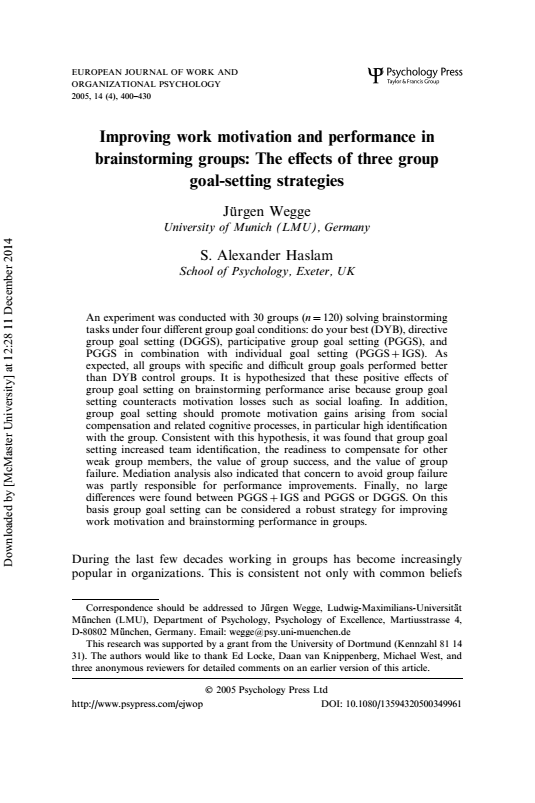Introduction
It is well-established that the motivation of employees has a direct impact on their performance and, consequently, on the profits of the company. Therefore, it is highly important to examine factors influencing motivation and motivational practices. In the course of the present research, I have examined the practices of Starbucks and its impact on work motivation. The study was based on the interviews conducted with the current employees of Starbucks, as well as the information received from the official websites of the company.
I have performed a detailed analysis of several factors that influence the motivation of the employees of Starbucks and the relationship between these factors and the practices of the company. Analyzing these issues, I used the goal-setting theory of motivation. Having analyzed these practices, I have worked out useful recommendations for Starbucks.
In the “Overview of the organization” part, I briefly describe the examined organization (Starbucks) and the products and services that it offers. In the same part, I explain how I have gathered the necessary data and give some basic information about the interviewed employees. The next chapter, “Findings,” is composed of two parts. In the first one, I plainly present the information that I have collected during the research process without analysis; in the second one, I give my analysis and assessment of the practices that I have discovered at Starbucks regarding work motivation. The next chapter, “Recommendations,” contains my recommendations for the improvement of the company, which I make with the consideration of the flaws discovered in the practices of Starbucks. Finally, the work presents a conclusion to my research.
Overview of the Organization
Starbucks is a well-known international network of quick service cafes based in Seattle, Washington. This organization started as a store selling tea, coffee, and spices in the early 70-s and emerged into a major company with thousands of retail stores in various countries. Starbucks offers its customers various sorts and blends of coffee and tea, several types of handcrafted beverages, and tools and equipment for brewing coffee and tea. In addition to beverages, Starbucks employees serve pastry, fast food, fruit, and yogurts (Starbucks Company Profile, n.d.).
Using my background knowledge, I have worked out a set of interview questions for my interviewees, as well as I have accessed the Starbucks website to receive both general information about the company and the more specific information related to the practices of the company that influence work motivation. The interview plan contained questions regarding the background of an interviewee (age, job position, tenure), questions related to the leadership practices they have used as leaders or have noticed their leaders using, their thoughts on their own performance and factors influencing it, their attitude to the job, the things they value and dislike about their job, and specific practices of the company such as the way of assigning tasks, establishing objectives, time management, and reward and punishment.
I have selected three interviewees from the local Starbucks store: Maria R., female, barista, 23 years old, working at this position for two years; James R., male, barista, 25 years old, working at this position for one year; and Alex H., male, 33 years old, store manager, who has been working as a barista for two years and as a manager for five years.
Findings
Goal-setting theory
As a basis for my research, I have used the goal-setting theory of motivation. This theory was developed by American psychologist Edwin Locke. According to Locke and his co-author Latham (2006), the motivation of employees depends on the goals that their leaders present to them. According to these scholars, goals need to be clear, measurable, achievable and challenging. Locke and Latham also stated that employees should be made part of the process of setting goals, as well as they should be provided with feedback and receive recognition (Locke & Latham, 2006).
Summary of the Gathered Information
Starbucks websites
A significant amount of data was gathered on the websites of the organization. The primary website emphasizes the willingness and strives of the company to contribute to the success of the employees. Instead of considering the employees of its workforce, the company regards them as partners. Along with promoting leadership among the employees, Starbucks encourages them to initiate and participate in a positive change of the world; this statement has a practical embodiment in the community service that Starbucks fulfills, such as helping community organizations and revitalizing neighborhoods, in which stores are located. Aside from this, Starbucks develops a personal package (“Your Special Blend”) for each partner.
The package allows the employees, who work enough hours a week, to receive some benefits, such as health coverage for their families (Working at Starbucks, n.d.). The management website recognizes the importance of motivation to increase job productivity and states that Starbucks is known for its ability to motivate employees effectively. The same website mentions the following ways, in which Starbucks motivates its employees. First, everyone is treated equally, which fact, as the company believes, can alone motivate the workers. Second, the company strives to maintain a friendly working environment that creates a sense of belonging in the employees.
Third, the company believes that providing the employees with benefits does good work to motivate them. Fourth, the organization is sure that satisfying the basic needs of the staff, such as safety (medical care), love (friendly environment), and esteem (career growth) helps to motivate them. Finally, Starbucks uses simple monetary motivation, claiming that “the more they contribute to the business, the more they get paid” (Motivation, n.d.).
Interview results
In the process of data gathering, I was lucky to receive quite different accounts from my three interviewees, which means that they have presented to me three different perspectives on motivation practices at Starbucks.
James R., barista, has described his experience at Starbucks in mostly negative tones. He acknowledged that he is quite dissatisfied with the leadership practices used by his manager (also my interviewee). According to him, the manager presents unclear and useless goals such as selling a particular amount of some kind of products (such as “100 sandwiches a day”). In addition, he told that all the benefits that Starbucks offers as motivation are overweighed by the fact that the company maintains the “customer is always right” principle, and rude customers kill all the motivation. James is also dissatisfied with the fact that promotions in Starbucks depend more on personal agreements with a manager than on seniority.
Maria R., also a barista, has presented a completely different account. Being an MBA student, she believes that their store manager is following the charismatic leadership style. According to her, this style creates a strong personal image, whose power helps employees to believe in the utter importance of the goals set by the leader. In such a way, charismatic leadership helps motivate employees. Maria is pleased with the fact that everyone is treated equally. She told, for instance, that managers are required to assist baristas in rush times, and they can even clean restrooms, which she has witnessed several times. The fact that senior staff does not have an elitist aura is inspiring for her. Additionally, she approves of the benefits that Starbucks offers and celebrates the flexible schedule.
Alex H., store manager, has shared a managerial perspective on working at Starbucks. He told that his superiors establish goals related more to business records than to customer or employee experience (to sell a precise amount of product in a given time). At regular meetings with his district manager, Alex has to report the success of his store. While he agrees that clear goals are necessary to motivate employees, these goals established by the company seem insufficient for him. Moreover, these goals contradict the mission statement of the company – “to inspire and nurture the human spirit.” In addition, his employees are often dissatisfied with such goals and blame him, which undermines his authority. Alex confessed that he planned to join corporate staff one day and change the goal-setting practices of the company.
Analysis of the Information
Having collected the data, I proceeded to conduct the analysis. My work was based on the premise that the perspectives of my interviewees and the company websites may be different from reality, and only the combination of various perspectives along with wise analysis with the involvement of my background knowledge can produce a valid research result.
Goal-setting
As I have heard from two of my interviewees, the company establishes clear and understandable goals for the employees. However, these goals are related to the pecuniary side of performance rather than to customer or employee experience.
I have reached a conclusion that Starbucks establishes such goals as to make employees improve their performance. These goals are clear and specific but are quite difficult at the same time. Thus, the employees do not experience difficulties when trying to understand what their managers want them to do: “do your best,” which is often established as a goal in customer service, is not precise enough for employees to comply while “sell 100 sandwiches today,” which Starbucks requires, is clear enough. At the same time, the goals are not easy to achieve, which makes the employees use additional effort and thus motivates them. In addition, such an approach is likely to have a positive impact on the effectiveness of teamwork since the goal requires a team effort (Kleingeld, Van Mierlo, & Arends, 2011).
As for teamwork, it is known that setting direct goals has a positive impact on group motivation and performance. It means that, in addition to motivating an individual to put effort into work for achieving the goal, the goal-setting of Starbucks also stimulates effective communication between the employees, the coordination of their efforts, and cooperation (Wegge & Haslam, 2005). Strengthening a team can also lead to negative consequences such as an unintentional reduction of working effort when working in a team, as well as withdrawing from working because of the presence of more capable colleagues or a feeling that group can achieve the goal without one particular person (Wegge & Haslam, 2005).
However, to achieve the established goals, Starbucks employees have to use the method of adaptive selling, i.e. the way of retail selling when a product is presented according to the needs and requirements of each particular customer. It is considered that adaptive selling has a positive impact on organizational success and employee motivation (Jaramillo, Locander, Spector, & Harris, 2013). However, in my opinion, the method that Starbucks uses does increase the motivation of employees to sell more products to customers, but it does not make them more inspired about their job and willing to work. Such kind of negative motivation is effective for some short periods of rush or emergency, but over time, it can lead to quick burnout in employees. I have concluded that this practice does increase sales but can lead to a high rate of employee turnover.
Therefore, the fact that Starbucks establishes direct, clear goals has a positive influence both on the individual motivation of the employees and on the motivation of a team. Nevertheless, the exclusively pecuniary nature of these goals can lead to quick burnout and a high turnover rate.
External incentives
It has been found that Starbucks promotes social change and encourages the participation of the employees in incentives that are not connected with their job responsibilities and can be considered charity or community work. In my opinion, such a measure is beneficial for the motivation of the employees. Changing the world is an inspiring and motivating goal. Providing employees with an actual opportunity to change the world breaks this global goal into smaller, achievable, clearer, and more understandable goals. It has been proven that extrinsic incentives at a workplace do not contradict work motivation. Moreover, the motivation for such initiatives has a direct impact on the motivation for work (Cerasoli, Nicklin, & Ford, 2014), which means that this practice is advantageous.
Leadership style
As it was mentioned, one of the interviewed employees (Maria) mentioned that their store manager (Alex) has been using the charismatic leadership style. While it can be true that one particular manager is using the elements of this style, I have concluded that the corporate structure and regulations of Starbucks promote the use of the transformational leadership style for the following reasons. First, Starbucks encourages change. Second, the company strives to create an ethical climate. Third, the company appeals to the moral ideals of the employees. It is known that transformational leaders are able to establish clear goals that are consistent with the ideals of the employees. Transformational leadership is recognized as especially beneficial for the motivation of the followers since the goals set by transformational leaders can be more challenging and specific (Bronkhorst, Steijn, & Vermeeren, 2013). Therefore, Starbucks is exercising an advantageous practice of promoting a leadership style that has a positive impact on motivation.
Equality
According to the interviewees, at Starbucks, the managerial staff is not considered elite, and managers may help employees with such tasks as serving customers or cleaning the store. Thus, equality is not merely proclaimed but maintained by the company. The positive effects of such measures on motivation are confirmed by one of my interviewees (Maria). Some scholars believe that maintaining equality at the workplace has a positive effect on motivation since employees feel more valued when treated equally to managers and thus become inspired and express more willing to work. Aside from this, when treated equally, employees receive equal means and resources to fulfill the goals that a manager assigns to them.
However, it is also known that individual differences have a significant impact on the relationship between equality and motivation, and, consequently, fulfilling goals, in each particular employee (Latham & Pinder, 2005). In this case, equality at the workplace makes Maria more inspired and motivated, but, at the same time, it does not make any visible effect on the work motivation of James.
Benefits
Among the important factors influencing the work motivation of the employees at Starbucks are the benefits offered by the company. The proposed benefits are quite substantial and, what is especially important, they depend directly on the work effort executed by an employee (Danish & Usman, 2010).
Moreover, the benefits make the employees, who receive them, feel rewarded, respected, and recognized. As I am convinced, the presence of benefits and the respectable aura that they have made a significant contribution to the motivation of the employees at Starbucks. The medical coverage for the families of the employees offered by Starbucks has an impact different from that of the pecuniary benefits. It makes the employees feel safe and increases their commitment to the working place, which is beneficial for their motivation. It is known that the presence of reward for hard-working employees is an advantageous method of increasing work motivation. Receiving a particular benefit is merely another goal, indirectly assigned by a manager to the employees; striving to fulfill that goal, an employee becomes motivated.
Self-efficacy
As I consider, by promoting teamwork and transformational leadership and offering benefits, the regulations of Starbucks aim to increase the sense of self-efficacy of the employees. However, the individual differences of the employees influence this relationship (Judge, Jackson, Shaw, Scott, & Rich, 2007). Being self-efficient, an employee receives a more solid resource to fulfill the goals assigned by the manager, which has a positive impact on their motivation.
Recommendations
Having analyzed the collected data and assessed the practices of Starbucks regarding the motivation of the employees, I have worked out the following recommendations for the company.
While the goal-setting strategy of the company is effective, efficient, and increases motivation, the pecuniary nature of the established goals leaves room for only a short-term motivation. As far as I am convinced, presenting such goals to the employees can be viewed as a threat rather than a challenge (Locke & Latham, 2006), which can affect the motivation of many employees. Starbucks should devote more attention to other goals, especially those related to customer and employee experience. For instance, the administration could hold conduct regular surveys among the customers and employees, and the ultimate goal would be to make the majority of answers positive.
I have acknowledged that the way, in which Starbucks presents goals to its employees, promotes teamwork and strengthening the team effort, which is certainly an advantage. Having established a different set of goals, such as the increase of the coordination in a team, bringing the level of performance of team members up to that of the best worker in that team, efficient communication, and knowledge transfer would definitely be beneficial for the motivation of the employees.
It is also a valuable idea to make customer satisfaction an actual, precise goal, especially considering that it is mentioned in the mission statement. For instance, the administration can check how many customers a store serves, how many returning customers it has, instead of merely counting the sold sandwiches. After receiving such figures, the administration can work out specific goals related to customer experience.
In addition, the company should establish a correlation between short-term and long-term goals, as well as it has to adjust goals to the specificities of the performance of each particular store. For instance, the requirements for sales have to change depending on the achievements of a particular store. If sales rates at a store are significantly lower or higher than at other stores, it should affect short-term goals, which, in their turn, should form short-term goals.
Aside from the mentioned above, I consider that Starbucks should distinguish learning and performance goals more effectively. Since the company establishes challenging goals for its employees (increasing the sales), it should provide them with specific knowledge that would allow them to achieve the performance goals. Having gained such knowledge, the employees would be trained to focus their attention on the specific details that are necessary to achieve the performance goal (Seijts & Latham, 2005).
Such an approach helps to reduce stress in the employees and boost their motivation. Establishing specific learning goals would lead to higher performance and, consequently, the growth of sales without employee burnout and the increase in turnover. Presenting learning goals to the employees would also teach them to perform time-management more effectively, as well as strengthen their self-confidence and self-efficacy. All these outcomes would cause an increase in the level of commitment among the employees of Starbucks. In the case of Starbucks, a performance goal is an increase in the sales of particular products; these goals are assigned to the employees, but no information regarding the ways of achieving this objective is given. As in many organizations, it is considered that the employees would find a way to achieve the goal by themselves.
The learning goal allows providing the employees with the necessary knowledge and skills. For Starbucks, the learning goal would be to “learn these specific techniques that would allow you to sell more products.” This goal is focused on skills acquisition rather than on the end result. Surely, companies do not have the luxury to let their employees take their time to gain all the necessary skills at their own pace. However, a balance between the company’s need to make profits and the needs of the employees is possible, and it is necessary to find this balance. Overall, Starbucks has already laid a strong basis for its goal-setting strategy, but some room for improvement still exists.
Next, I recommend Starbucks to leave “the customer is always right” policy behind. Not only is this unfair to refuse to stand by a loyal employee while they are facing unjust treatment from rude or unreasonable customers, but it is also ineffective in terms of customer service and, more importantly for this research, employee motivation. As one of my interviewees told us, the employees of Starbucks, especially baristas, often have to deal with arrogant or angry customers, who break the rules and the regulations regarding behavior and service at a Starbucks store (for instance, go behind the bar counter or demand a product that cannot be served at Starbucks such as alcohol).
Having no power to protect themselves from such customers makes the employees stressed out. Surely, there are examples of irresponsible employees, who do not serve the customers properly; however, it does not mean that the right is always with the customer. In each case of a conflict between a customer and an employee, a manager is able to investigate the situation and make a just decision. Encouraging the abusive behavior of some customers means that the employees have to execute additional effort to serve these particular customers. Favorable treatment would probably encourage such customers to visit a store more often, which, along with the increase of the sales, can lead to a higher rate of employee turnover and seriously lower the motivation. The constant turnover of employees will eventually cost the company more than losing several rude customers.
Taking the side of the employees instead of forcing the maxim “the customer is always right” on them would lead the company to a higher level of customer service since the employees would be more confident and motivated. The main problem with such a policy is that it makes the entire goal-setting process of the company unclear. For instance, the following imaginary situation may take place. An employee has a clear, achievable goal of selling a particular amount of sandwiches. Then, an angry customer, who wants to buy alcohol at Starbucks, starts yelling at the employee. The administration takes the customer’s side, saying that the employee should have pleased the customer.
Thus, a clear, understandable goal “sell 100 sandwiches” transforms into the blurry, unclear, and not measurable “please the customer by all means,” which hinders the working process and kills motivation. In any case, pleasing customers would not be possible without motivated employees, who are enthusiastic about customer service.
Finally, I believe that the best model of motivation for the employees of Starbucks, considering their complicated schedule and the challenging goals that they have to achieve, is proactive motivation. Adopting this model would allow the employees to be more confident, flexible, and ready to change, as well as it will help them to prevent or eliminate problems (Parker, Bindl, & Strauss, 2010). The proactive model requires the employees to initiate an effort to bring changes in the working practices executed by the company.
This model is also consistent with the goal-setting strategy of Starbucks. Proactivity requires generating a specific proactive goal and putting a significant effort into achieving that goal. A range of prospective proactive goals can be generated at Starbucks. These goals can be divided into two groups: the future objectives (such as increasing the sales rate, making the customer experience brighter, sophisticated the organizational structure of Starbucks, becoming more adjusted to the working environment) and the immediate goals (coordinate a team effort to serve customers perfectly during a rush). Proactive goals lie in two dimensions: the individual development of an employee and the development of the company.
Proactivity involves three types of motivation that appear to be beneficial for the job satisfaction and organizational performance of the employees at Starbucks. The three types of motivation are the following. The “can-do” motivation emerges from the increased self-efficacy and control. The “reason to” motivation is related to the nature of the motivation of an employee (it answers the question “why an employee is motivated”). The “energized to” motivation is related to the mood and setting of an employee and their willingness to work and perform particular tasks. Having employed the proactive motivation model along with the other recommendations, made in the course of their research, the company will be able to boost the motivation of the employees, which will have a positive effect on their performance.
Conclusion
Having performed a thorough analysis of the practices of Starbucks and its influence on the motivation of the employees on the basis of the information gathered from the interviews with the employees and the official websites of Starbucks, I have reached the following conclusions. The practices of Starbucks have a positive impact on the motivation of the employees by means of setting clear goals. Other aspects of this impact include promoting teamwork, encouraging transformational leadership, including external incentives, maintaining equality, offering benefits, and promoting self-efficacy. These aspects give an employee the resource and means necessary for fulfilling the goals assigned by managers.
However, the practices of the company execute a negative influence on the process of setting and fulfilling goals by establishing exclusively pecuniary goals and employing the “customer is always right” policy. My recommendations to Starbucks include the abolition of such policy, as well as establishing learning goals along with performance goals and adopting the proactive model of motivation.
References
Bronkhorst, B., Steijn, B., & Vermeeren, B. (2013). Transformational leadership, goal setting, and work motivation: The case of a Dutch municipality. Review of Public Personnel Administration, 35(2), 124-145. Web.
Cerasoli, C. P., Nicklin, J. M., & Ford, M. T. (2014). Intrinsic motivation and extrinsic incentives jointly predict performance: A 40-year meta-analysis. Psychological Bulletin, 140(4), 980-1008. Web.
Danish, R.Q., & Usman, A. (2010). Impact of reward and recognition on job satisfaction and motivation: An empirical study from Pakistan. International Journal of Business and Management, 5(2), 159-167. Web.
Jaramillo, F., Locander, W.B., Spector, P.E., & Harris, E.G. (2007). Getting the job done: The moderating role of initiative on the relationship between intrinsic motivation and adaptive selling. Journal of Personal Selling & Sales Management, 27(1), 59-74. Web.
Judge, T.A., Jackson, C.K., Shaw, J.C., Scott, B.A., & Rich, B.L. (2007). Self-efficacy and work-related performance: The integral role of individual differences. Journal of Applied Psychology, 92(1), 107-127. Web.
Kleingeld, A., van Mierlo, H., & Arends, L. (2011). The effect of goal setting on group performance: A meta-analysis. Journal of Applied Psychology, 96(6), 1289-1304. Web.
Latham, G.P., & Pinder, C.C. (2005). Work motivation theory and research at the dawn of the twenty-first century. Annual Review of Psychology, 56(1), 485-516. Web.
Locke, E.A., & Lathan, G.P. (2006). New directions in goal-setting theory. Current Directions in Psychological Science, 15(5), 265-268. Web.
Motivation. (n.d.). Web.
Parker, S.K., Bindl, U.K., & Strauss, K. (2010). Making things happen: A model of proactive motivation. Journal of Management, 36(4), 827-856. Web.
Seijts, G.H., & Latham, G.P. (2005). Learning versus performance goals: When should each be used? Academy of Management Executive, 19(1), 124-131. Web.
Starbucks company profile. (n.d.). Web.
Wegge, J., & Haslam, S.A. (2005). Improving work motivation and performance in brainstorming groups: The effects of three group goal-setting strategies. European Journal of Work and Organizational Psychology, 14(4), 400-430. Web.
Working at Starbucks. (n.d.). Web.
Appendices

